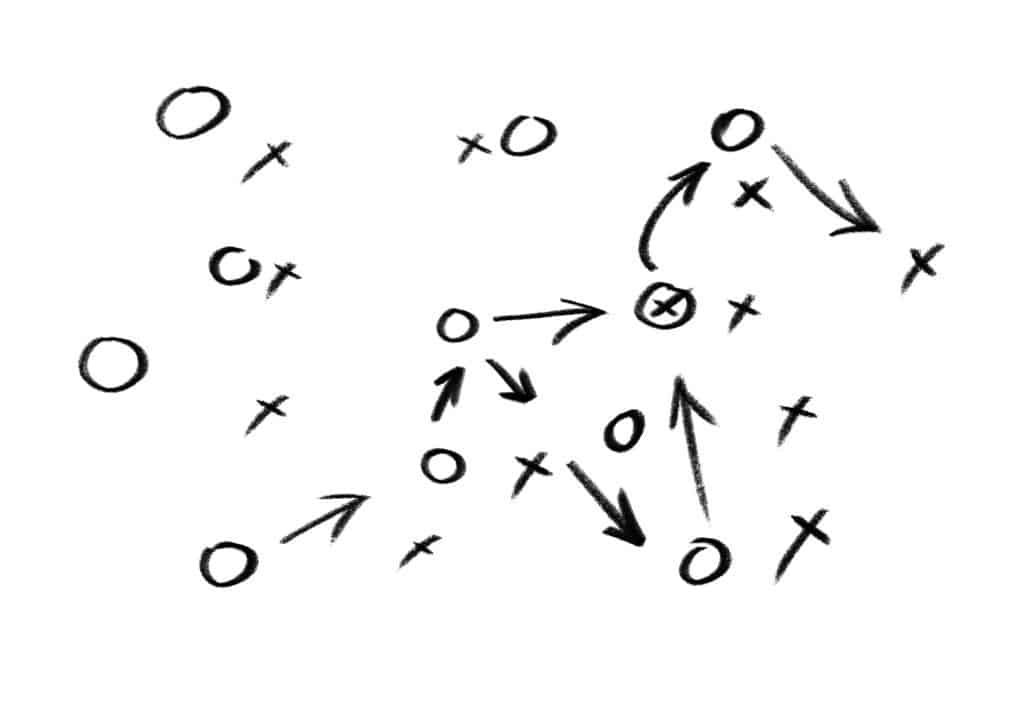5-step Content Audit Checklist [With a Template!]

A cornerstone of any powerful content marketing strategy begins with a comprehensive content audit — a deep dive into what’s working, what’s flopping, and what needs some mending. Doing so will help you spot gaps and opportunities, find avenues for optimization, build brand consistency, and more.

When your audit reveals content gold and suddenly your ideas are getting the slow clap.
One way to think about an audit: Say you’re making dinner. You have to know what ingredients are at your disposal, right? But to create some happy, sated customers (or, more likely, family members), it’s also helpful to know what food you’ve made before that’s been well-received and what has been a no-go. With your list of ingredients and order preferences, you can be more confident you’ll serve up a great dish. That’s the basic idea behind an audit. It’s a way to see what you have, understand what’s worked well, and provide a guide on how to make even better content moving forward.
What Is a Content Audit?
The definition of a content audit is the process of examining all the content you have, including work that’s been published physically and online, as well as emails, newsletters, podcasts, and more.
A content audit is your big-picture close-up of everything you’ve created, from blog posts and newsletters to that forgotten webinar recording from two years ago.
Now that you’ve taken inventory, it’s time to dig into the real work — figuring out what’s working, what’s flopping, and what just needs a little polish. If you haven’t been keeping tabs on your content’s performance with content marketing measurement, this is where things can get messy. But don’t worry, we’ve got a plan to help you make sense of it all.
In your audit, you’ll want to assess:
- Did your content meet your marketing key performance indicators (KPIs)?
- Has it hit your content measurement framework goals?
This assessment sets you up to identify and optimize underperforming content while also pursuing more of the content that has been working well.
Why Do You Need a Content Audit?
Content marketing audits help you pinpoint content effectiveness, boost member engagement, and improve brand consistency — all of which can help drive overall content and organizational success.

We listen and we don’t judge. There’s no shame in finding improvements through a content audit.
A content audit can help your organization:
- Spot outdated content before Google does. You can then fix, refresh, or remove it to boost your search rankings.
- Streamline content creation. Identify topics that are missing the mark, ones you’ve covered in-depth, and areas that you should cover in the future. By doing this, your whole team can focus their time where it matters most.
- Increasing audience engagement. Double down on your top-performing content and focus on those topics to boost engagement. The audit will also help you hone your calls to action, find the optimal time to post content, and figure out what platforms are best.
- Improve brand consistency. Organizations change over time. Content that was aligned with a seven-year-old mission might not be relevant today. A content audit will flag this outdated content and help align tone, voice, and branding across all channels.
- Repurpose your best work. A content audit can reveal valuable opportunities for breathing new life into old content. For example, a series of related blog posts might combine to create a high-value e-book that can be used for lead generation. Or, you could break up tips in a blog post to create a visual LinkedIn carousel.
More on SEO for Content
Search engines ding sites with outdated information, broken links, and SEO missteps — but lucky for you, a content audit can fix all that. With an audit, you also have the opportunity to update more granular items, like certain title tags, metadata, and internal links. This work of updating can improve your overall search rankings, resulting in more people engaging with your content — and exactly the topics and pages you want them to.
How to Perform a Content Audit in 5 Steps
Here are the five steps we use to provide content audits for our clients:
1. Define Your Content Audit Goals
Start by setting clear goals for your content audit. What story do you want your data to tell? Are you optimizing for SEO, refining audience engagement, or fine-tuning your lead gen strategy?
Your overall goals will drive what metrics matter most. For example:
- Timeframe. How frequently do you update content?
- Quality. Does your design and editorial style meet your brand standards?
- Audience & Reach. Are you hitting the right people with the right message?
- ROI. Even anecdotal wins count.
- SEO Performance. How are your keywords, metadata, and rankings holding up?
- Effectiveness. Does your content fit into your marketing funnel and support your overall business objectives?
Bonus: Grab our customizable content audit template to make the process seamless.
2. Identify the Content You Have
Once you’ve established your content audit template, start taking stock of the content you have across every channel. This can include:
- Website and blog content
- Print content such as magazines and newsletters
- Email content, including e-newsletters and automated emails
- Video content on channels like YouTube
- Social media content
3. Analyze Content Performance and Quality
Once you start your content audit, you’ll likely quickly notice high-level trends about your content. Some topics are covered exhaustively while others are neglected. You might recognize that podcast production wanes in the summer or that social media posts only go out in the morning.
You’ll also start noticing what content is performing well and what is sinking.
While these broad insights are handy, you’ll also want to dive into specifics by leaning on your identified goals. For example, if your audit goal is to increase member retention through content, you might assess:
- Bounce rate and page views per session for your blog, a key member benefit
- Click-through rates for your e-newsletter, another key member benefit
- Participation in member-only content, like webinars
- Engagement metrics for conference content
Side note: A content audit is the perfect time to measure your site and content for accessibility and ADA compliance — because your content should work for everyone.
4. Create an Action Plan
Now it’s time to make the hard calls and decide what stays, what goes, and what gets reworked.
- Keep and amplify
- Refresh and optimize
- Cut and replace
If your content is worth keeping and doesn’t need tweaking, look for ways to promote or feature it again — or think about ways to repurpose it on other channels.
Refreshing work could be as simple as:
- Updating a few keywords and the headline
- Refreshing statistics and updating data
- Fixing broken links and resized images
Some content will need to be removed entirely. If it’s outdated, factually incorrect, or now completely irrelevant, it’s time to cut it loose.
5. Implement and Monitor Results
Establish a clear timeline for updating your content by creating a content calendar. Like with any other content campaign, track the performance over time, paying specific attention to how the content performs according to your goals.
How often should you audit?
“A content audit isn’t just a box to check — it’s a strategic checkpoint. As a best practice, you should perform one at least annually, ideally alongside your strategic planning for the year,” says Janet Celosia, Vice President, Marketing Strategy, BackPocket Agency.
She explains that the best time to do this is year’s end, when you can take a comprehensive look at what’s working, identify gaps, and refine your approach for the year ahead. “And if you don’t have a full year’s worth of data yet, that’s OK,” Celosia says. “Starting at year’s end sets you up for a regular, annual cadence.”
That said, audits shouldn’t be limited to a set schedule. “If your content program undergoes a major change, such as a branding overhaul or a shift in strategic direction, that’s a key moment to reassess and ensure your content aligns with your new vision,” she says.
Ready to Supercharge Your Content Marketing?
At BackPocket Agency, we’re more than just content creators — we’re strategic partners committed to helping you achieve your marketing goals. With our comprehensive content strategy services, we’ll guide you through every step of the process, ensuring that your content doesn’t just exist but thrives. Let’s work together to create a content strategy that not only tells your story but drives your success. Reach out to BackPocket to start strategizing today.
How to Find the Right Content Strategy Agency
Great content marketing starts with a solid game plan. That’s where a content strategy agency comes in. They don’t just…
How Content Marketing Can Help Small Businesses
There’s no sugar-coating it: When you’re operating a small business, it’s next to impossible to match — or even come…
5-step Content Audit Checklist [With a Template!]
A cornerstone of any powerful content marketing strategy begins with a comprehensive content audit — a deep dive into what’s…
What Content Marketing KPIs Should You Track?
It’s no secret that many people are drowning in data. And for content marketers, too much data is just as…
How to Create a Content Measurement Framework
When it comes to consistent, effective content marketing measurement, the data doesn’t lie. The Content Marketing Institute’s B2B Content Marketing…
Content Strategy vs. Content Marketing
Content strategy and content marketing. You no doubt have heard of them and know that each is essential to helping…
The 7 Steps to Plan a Content Strategy
Your blog started with good intentions. Boost SEO, check. Get more engagement, check. But somewhere along the way, things got…
Which Content Marketing Solutions Are Right for You?
The biggest difference between content marketing and marketing? Content marketing’s focus on storytelling to connect, educate, and motivate through value,…
How to Create a Content Marketing Framework [With Templates]
Ever feel like your content marketing is a chaotic free-for-all? You need a content marketing framework. Think of it as…
How to Use AI to Build Smarter Audience Personas in Minutes (Not Days)
As content strategists, we all know the value of audience personas — those detailed profiles that help bring your target…










